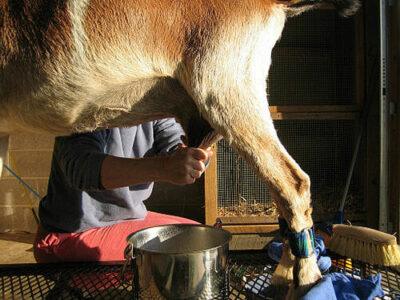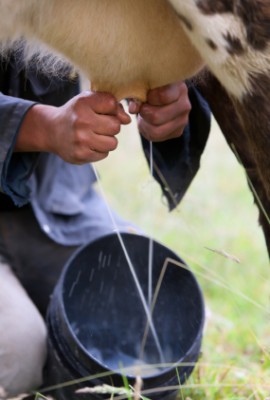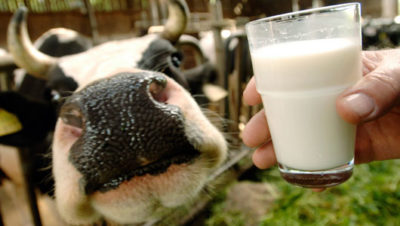|
Listen To The Article
|
Whether you have been a longtime homesteader or are just getting started, you probably have a cow or a small herd of goats to provide you with milk. The first thing to know is how to properly treat the raw milk you’ve gotten from your cow or goats.
People often wonder about the differences between fresh milk straight from the cow and milk purchased at the grocery store. The main difference is that store bought milk has been processed so much that it almost isn’t milk anymore. Store milk is homogenized, meaning milk from many different cows are mixed together. This is so the whole batch tastes the same and has a consistent texture. Homogenizing isn’t for safety purposes.
Store milk also is pasteurized. The debate on whether or not raw milk is safe to drink is just as hot today as it was back in the 1980s. Unfortunately, many people taking sides in this debate have not done their own research. They are simply parroting the excuses given by the FDA and CDC on why raw milk is bad for us.
There have been federal laws regulating milk production and distribution since the 1980s. But no one thought anything about those laws being antiquated until relatively recently. After all, the FDA just wants to keep us safe, right? One side believes that the government simply wants to offer the people a safe food while the other side believes that the government just wants more money from their supporters who are adamantly against people being able to get raw milk instead of having to pay for all the processing that goes into store-bought milk. Plus, many off-gridders believe raw milk is healthier.
What is not debatable is that pasteurization can extend the life of milk.
Handling Raw Milk
Safe milk handling starts with the environment in which you will be milking your animal. Your milking station needs to be clean. It doesn’t have to be completely sterile and covered in bleached cement or stainless steel, but it does have to be clear of fecal material and excessively dusty surfaces. Make sure your floor covering is clean. If your floor is dirt make sure that the straw the bucket will sit on is clean and fresh.
The second thing to do is to make sure your cow or goats are healthy and clean. An unhealthy animal will give low quality and potentially dangerous milk. Be sure to take your animal to a reputable veterinarian to keep her healthy.
 [2]The third is to be sure that your equipment is completely sanitary. Seamless, stainless steel buckets are the best to use for milking animals and they usually come with a lid. You do not want to use plastic buckets since plastic is porous and milk will be able to soak into the pores of the plastic. This will allow bacteria growth and souring of your milk. Never bring glass into the milking area since the animal might fidget and then you’d have glass shards to clean up. We will discuss sanitizing your equipment later on in the cleaning up portion of this article. If your milking station is clean, the bucket is sanitized, and the animal is healthy, you’re ready to milk.
[2]The third is to be sure that your equipment is completely sanitary. Seamless, stainless steel buckets are the best to use for milking animals and they usually come with a lid. You do not want to use plastic buckets since plastic is porous and milk will be able to soak into the pores of the plastic. This will allow bacteria growth and souring of your milk. Never bring glass into the milking area since the animal might fidget and then you’d have glass shards to clean up. We will discuss sanitizing your equipment later on in the cleaning up portion of this article. If your milking station is clean, the bucket is sanitized, and the animal is healthy, you’re ready to milk.
Steps to ensuring your raw milk is safe:
- Using warm water with or without a mild soap and a soft, clean cloth, wash your animal’s udder, especially the teats. You will want to scrub rather well to get rid of all the dirt, grass, hay and fecal matter she may have picked up when she was laying down out in the pasture. This step will do two things – clean her udder and help her to let her milk down so that it is easier to milk her.
- Once she is clean, squirt the first two or three streams of milk into a separate container or onto the floor. It won’t hurt your barn cats or other animals but it might contain bits of dirt or other material you wouldn’t want in your milk. It’s also a good way to find out if your animal is suffering from mastitis as the first few squirts will show any puss present in the output.
- Now you are ready to get down to the business of milking. Make sure your hands are clean before you start. Get every drop of milk your cow or goat has to offer before setting your bucket aside.
Milking:
- Cover your bucket with the lid to keep the odd bits of floating debris or a curious dog or cat from getting into the milk. Keeping your bucket covered on the trek back to the house or wherever your milk room is will help keep rain, snow, leaves and the like out of the milk as well.
- Once you are back at the house or milk room, you are ready to start the process that makes your fresh, raw milk drinkable. The next thing to do is to strain your milk. This will remove any of the tiny particles of hay, hair, dirt and other things from your milk. You can easily do this with a canning funnel and a coffee filter. However, there are several dairy suppliers who carry stainless steel strainers. You will transfer your milk from the bucket into quart or half gallon sterilized mason jars.
- The next and most important step is to cool the milk down quickly. This is the reason you aren’t putting a full bucket of milk into the refrigerator. The smaller containers will cool down much more quickly than a larger one. To preserve its freshness and keep it safely drinkable, chill the milk to at least 40 degrees. Store your jars of milk toward the back of the refrigerator as this area is the coolest. You might consider keeping a second refrigerator for milk only. This rapid cooling inhibits bacteria growth and keeps your raw milk tasting better for longer periods of time. Just remember that if your raw milk has soured naturally, it is still good and can be used in a variety of ways.
That’s all there is to it!
Your milk is ready to use in cooking or to drink by the glassful, however you wish to use it. However, you may not be able to use all of the milk your animal provides on a daily basis very quickly. If you do not sell or give away your excess milk or make butter and cheese out of it, you’re going to be neck deep in milk in a very short while. Pasteurizing your milk will let it last a little longer than just the regular four or five days. The procedure is relatively simple and can be done easily on your kitchen stove.
The process of pasteurization consists of raising and maintaining the temperature of the milk for a certain length of time. The recommended process is keeping the milk at 161 degrees for 15 to 20 seconds.
There are three different methods you can use to pasteurize your raw milk at home.
Stovetop
This is not the recommended method, but it can be used if necessary. Since it takes such a long time to heat milk to a higher temperature, it is tempting to walk away. This is not a good idea! You will need to stand at the stove and stir constantly. The bottom of the pan you are heating your milk in will get to a much higher temperature faster than the top of the milk. If you walk away, you are inviting scorching to happen. Scorching the bottom of your pan will affect the entire pot of milk. It will stink up the whole house and turn drinkable milk into dog, cat, pig or chicken food.
Double Boiler
This is the most recommended method for pasteurizing your milk. This method ensures that your milk will not scorch even if you walk away for a few moments. You will still need to stir the heating milk but not as consistently as if the milk were heating on direct heat.
Home Pasteurizer
This is basically a double boiler with a thermometer, a timer and a cool-down process built in. The least expensive apparatus you will find is going to be around $300 and the cost goes up from there. These units allow you to pasteurize your milk without having to stir or wait on a timer. It stirs and buzzes when it is time to switch it to the cool-down phase. Remember that if you purchase a pasteurizer, there will be some learning you must do to know how to properly use the unit.
 The last step in handling your milk safely after pasteurizing it is to cool it down quickly to prevent bacterial growth that can cause it to sour early or taste odd.
The last step in handling your milk safely after pasteurizing it is to cool it down quickly to prevent bacterial growth that can cause it to sour early or taste odd.
- If you are using a pasteurizing unit, it will include a cool-down process so nothing different will need to be used.
- Otherwise, place the pot into an ice bath. You also could put the pot into the freezer for an hour or so. Keep a lid on the pot so that no moisture gets into the cooling milk. Moisture at this stage would cause a skin to form on the top of the milk.
- Pour the milk into a shallow, stainless steel pan with a lid. Place the pan in the refrigerator or freezer until the temperature reads 45 degrees.
Once your pasteurized milk is cooled, you can pour it into glass jars for storage.
There is one more thing that must be done before you are completely finished with this task, though. The cleaning and sterilizing of any equipment you have or will be using the next time you need to milk your animal or store your milk.
Cleaning and sanitizing your equipment:
- Rinse out your bucket and any other equipment that has been in contact with raw milk with cool to warm water. This will remove any milk solids that have dried onto the surfaces.
- Once everything has been rinsed off, you can wash everything by hand with hot water and a mild dish soap. Thoroughly rinse the soap off and allow to drip until you are ready to sterilize everything.
- Sterilization can be done in two ways:
- You can run the items through your dishwasher if it has an automatic sanitation setting.
- You can put a pot of water on to boil. Once it is at a rolling boil, place your glass storage jars in the water making sure they are completely submerged for about thirty seconds. Using a pair of canning tongs, lift the jars out and drain all the water out of them. Carefully set them on a drying rack and allow them to air dry just as if you were canning. This can be done with the lids and the bucket you used for milking as well. Be careful as the jars, lids and bucket will be very hot to the touch after being in the boiling water.
Congratulations! You have just ensured that the milk you prepare for your family will be safe and delicious.
Do you ever pasteurize your raw milk? Share your thoughts on the process in the section below:
Harness The Power Of Nature’s Most Remarkable Healer: Vinegar [3]
